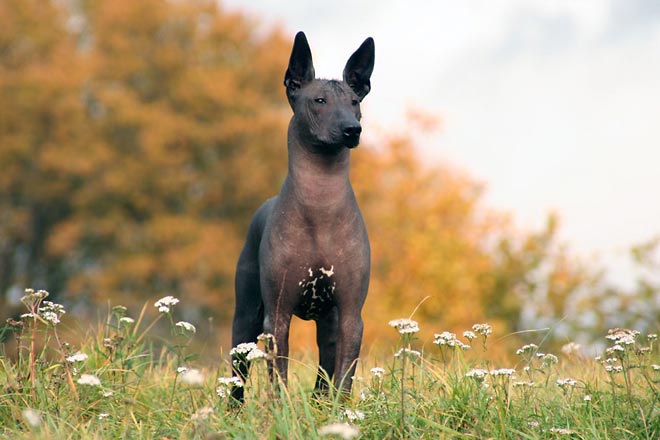The Xoloitzcuintle or Xolo, also known as the Mexican hairless dog, is one of several breeds of hairless dog. It is found in toy, miniature, and standard sizes. The Xolo also comes in a coated variety and coated and hairless can be born in the same litter. It is characterized by its lack of hair, wrinkles, and dental abnormalities. In Nahuatl, from which its name originates, its name is xōlōitzcuintli and xōlōitzcuintin. The name comes from the god Xolotl and itzcuīntli, meaning dog in Nahuatl.
History
Archaeological evidence has been found in Colima dating similar dogs to over 3500 years ago. Long regarded as guardians and protectors, the indigenous peoples believed that the Xolo would safeguard the home from evil spirits as well as intruders. Ceramic representations of the Xolo, known as Colima Dogs, have been found in hundreds of burial sites. In ancient times the Xolos were often sacrificed and then buried with their owners to act as a guide to the soul on its journey to the underworld. They have been found in burial sites of both the Maya and the Toltec. These dogs were considered a great delicacy and were consumed for sacrificial ceremonies–including marriages and funerals. Most likely, these pre-European dogs originated as spontaneous hairless mutations of indigenous American dogs. Hairlessness may have conferred a survival advantage in tropical regions. Indigenous peoples of Mexico had Xolo dogs as home and hunting companions, and today they are still very popular companion dogs. Their value in ancient native cultures is evidenced by their frequent appearance in art and artefacts.
Pre-European Xolos were considered sacred dogs by the Aztecs, Toltecs, Maya, and other groups. They were also useful companion animals. According to Aztec mythology, the god Xolotl made the Xoloitzcuintli from a sliver of the Bone of Life from which all mankind was made. Xolotl gave this gift to Man with the instruction to guard it with his life and in exchange, it would guide Man through the dangers of Mictlan, the world of Death, toward the Evening Star in the Heavens. Some people in Mexico continue to believe this breed has healing qualities. The Aztecs also raised the breed for their meat. Sixteenth-century Spanish accounts tell of large numbers of dogs being served at banquets. Aztec Merchant feasts could have 80–100 turkeys and 20–40 dogs served as food. When these two types of meat were served in the same dish, the dog meat was at the bottom of the dish, either because it was held in higher regard or because it was increasingly considered a step above cannibalism.
The Aztecs consumed few domesticated animals like Xolos or turkey. Over 90% of the bones found at archaeological sites are of deer that were hunted.
The breed is not historically well known in the United States. As a result, the Xolo has been mistaken for the mythical Chupacabras of Mexico.
On August 12, 2016, the Mayor of Mexico City Miguel Ángel Mancera designated the Xoloitzcuintle as a “cultural heritage and symbol” of Mexico City
